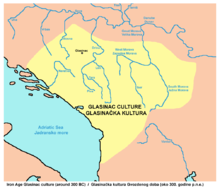
Back Glasinačka kultura BS Glasinačka kultura Croatian Glasinaci kultúra Hungarian Cultura di Glasinac Italian Kultura Glasinac Polish Гласинацкая культура Russian Glasinačka kultura Serbo-Croatian Kultura Mati-Drilon Albanian Гласиначка култура Serbian
 | |
| Geographical range | Western Balkans |
|---|---|
| Period | Late Bronze Age - Middle Iron Age |
| Dates | c. 1600 — c. 300 BC |
The Glasinac-Mati culture is an archaeological culture, which first developed during the Late Bronze Age and Early Iron Age in the western Balkan Peninsula in an area which encompassed much of modern Albania to the south, Kosovo to the east, Montenegro, southeastern Bosnia and Herzegovina and parts of western Serbia to the north. It is named after the Glasinac and Mati type site areas, located in Bosnia-Herzegovina and Albania respectively.
The Glasinac-Mati culture represents both continuity of middle Bronze Age practices in the western Balkans and innovations specifically related to the early Iron Age. Its appearance coincides with a population boom in the region as attested in numerous new sites which developed in that era. One of the defining elements of Glasinac-Mati is the use of tumuli burial mounds as a method of inhumation. Iron axes and other weapons are typical items found in the tumuli of all subregional variations of Glasinac-Mati. As it expanded and fused with other similar material cultures it came to encompass the area which was known in classical antiquity as Illyria.[1]
- ^ Stipčević 1977, p. 108.
© MMXXIII Rich X Search. We shall prevail. All rights reserved. Rich X Search